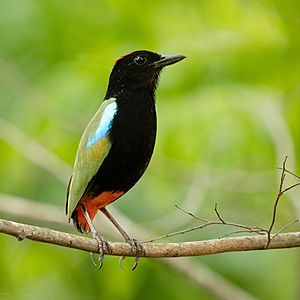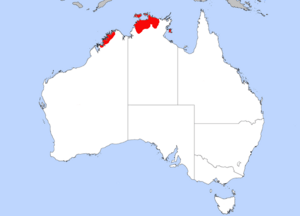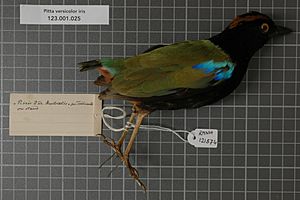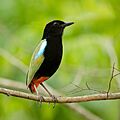Rainbow pitta facts for kids
Quick facts for kids Rainbow pitta |
|
|---|---|
 |
|
| Conservation status | |
| Scientific classification | |
| Genus: |
Pitta
|
| Species: |
iris
|
 |
|
| Range in red | |
The rainbow pitta (Pitta iris) is a small, colorful bird found only in northern Australia. It belongs to the pitta family. This bird is known for its striking looks: a black head with chestnut stripes, olive-green upper parts, and a bright red belly.
Like other pittas, the rainbow pitta is a shy bird that likes to stay hidden. It mostly eats insects and other small creatures. Rainbow pittas build large, dome-shaped nests and lay three to five eggs. Both parents take care of the eggs and chicks. Even though it lives in a small area, it's quite common there. Because of this, experts say it's a species of least concern, meaning it's not currently in danger.
Contents
About the Rainbow Pitta's Name
The rainbow pitta was first described in 1842 by an English bird expert named John Gould. He found a specimen in the Northern Territory of Australia. The name iris comes from an Ancient Greek word meaning "rainbow." This is also why we call it the rainbow pitta!
For a while, some thought the rainbow pitta was a type of noisy pitta, which lives in eastern Australia. But studies of its DNA showed that its closest relative is actually the superb pitta from Manus Island near Papua New Guinea.
What Does a Rainbow Pitta Look Like?
The rainbow pitta is about 16 to 18 centimeters (6 to 7 inches) long. It weighs between 52 and 88 grams (1.8 to 3.1 ounces). Females are usually a little heavier than males.
This bird stands upright when it's looking for food or resting. Its head, neck, and chest are a velvety black. Its back is olive-green, and its lower belly is a bright scarlet red. The wings are green with a shiny blue patch. Its tail is olive-green. It has a black beak, pink legs, and brown eyes. A chestnut-colored stripe runs along each side of its head, above its eyes.
Both male and female rainbow pittas look very similar. It's hard to tell them apart just by their feathers.
Where Do Rainbow Pittas Live?
The rainbow pitta lives only in the Northern Territory and Western Australia. It's the only pitta species that is found only in Australia. In the Northern Territory, you can find it in the Top End, from Darwin to the Arnhem Escarpment. It also lives on islands like Groote Eylandt. In Western Australia, it's found along the coast of the Kimberley region.
These birds mostly live in monsoon forests. They also like nearby vine-scrubs and gallery forests. Sometimes, they can be found in eucalypt forests, bamboo forests, and even near the edges of mangrove forests. They prefer closed forests but can also be seen in more open areas.
Rainbow pittas usually stay in the same area all year round. They don't migrate far. Young birds will leave their parents' territory to find their own space.
Rainbow Pitta Behavior
Calls and Displays
Rainbow pittas use different calls and movements to talk to each other. Males call more often than females, especially during the breeding season. They start calling about an hour before sunrise.
One special behavior is the bowing display. The male bird stands tall, then bows down until its chest almost touches the ground. While doing this, it makes a soft purring sound. This display helps birds mark their territory. It's designed to be seen in the dim forest light without attracting predators. Their most common call sounds like "teow-whit, teow-whit."
When a predator is near their nest, rainbow pittas might flick their wings or spread them open suddenly. This can distract the predator away from the nest. If an adult bird feels threatened, it might duck down low to the ground.
When one parent takes over incubating the eggs from the other, they have a simple routine. The arriving parent whistles a few times from a nearby branch. The parent on the nest then quietly leaves, and the new parent takes its place.
What Do Rainbow Pittas Eat?
The rainbow pitta is special because it only looks for food on the ground. Its diet mainly includes insects, their larvae, other arthropods, snails, and earthworms. Near Darwin, earthworms make up a big part of their diet, especially during the rainy season. In the dry season, they eat more insects like cockroaches, beetles, and ants. They also eat spiders, centipedes, and sometimes even frogs or lizards. They might also eat fruits that have fallen to the ground.
To find food, the pitta hops along the forest floor, then stops to look around. It uses its feet to scratch at leaves and soil. It can also flick leaves away with its beak. When it finds a snail, it breaks the shell using roots as a tool. For bigger prey like large centipedes, it shakes them and drops them before eating.
Rainbow Pitta Reproduction and Life Cycle
Rainbow pittas are monogamous during the breeding season, meaning they have one partner. However, they don't usually stay with the same partner for life. They often find new partners each year.
The breeding season runs from December to April. This time matches when there's plenty of food, especially earthworms, which are important for feeding their chicks.
Rainbow pittas build their nests in their territory, which can be about 1.6 to 3.1 hectares (4 to 7.7 acres) in size. They don't use the same nest twice. If they lay more eggs in the same season, they build a new nest. Unlike some other pittas, rainbow pittas rarely build their nests very close to the ground. This might be because their habitat can flood easily. They can build nests anywhere from ground level up to 20 meters (65 feet) high in a tree.
It takes about a week for both parents to build a nest. They start with a platform of twigs, then build a dome over it. Inside, they line the nest with bark, leaves, and fine fibers. A unique thing about rainbow pitta nests is that they often add wallaby dung pellets to the entrance. No one is sure why they do this. Some think it might hide the smell of the nest from predators, but studies show it doesn't always help. They might also decorate nests with other things like dingo hair or feathers.
Rainbow pitta nests can be attacked by rodents and snakes. Nesting failure is quite high, especially in monsoon forests.
A female rainbow pitta usually lays four eggs, but sometimes three or five. The eggs are white with brown spots. Both parents sit on the eggs for 14 days. The chicks are born without feathers and have black skin. Their eyes open after four days. Both parents feed the chicks very often. Earthworms are broken up for the smaller chicks.
Chicks leave the nest after 14 days, even before they are fully grown. They are fed by their parents for another 15 to 20 days. After that, they become independent. Sometimes, parents will even build a new nest and lay a second set of eggs while still feeding the first group of chicks!
Rainbow Pitta Conservation Status
The rainbow pitta is not considered to be in danger of extinction. It lives in a small area, but it's generally common there. For example, in Kakadu National Park, you can find about one bird per 10,000 square meters (2.5 acres).
The subspecies found in Western Australia, P. i. johnstoneiana, might be facing some challenges. Feral cattle can damage its habitat, which might be causing some decline in their numbers. However, overall, the International Union for Conservation of Nature (IUCN) lists the rainbow pitta as a species of least concern. This means it's not currently threatened.
Images for kids
See also
 In Spanish: Pita arcoíris para niños
In Spanish: Pita arcoíris para niños








